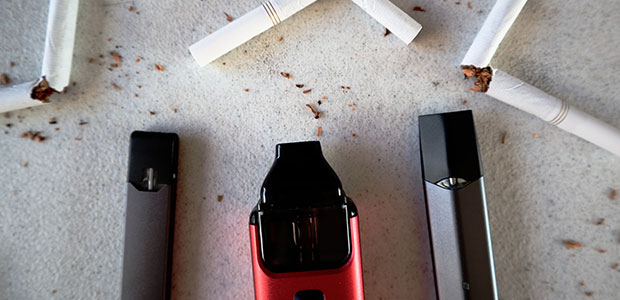
Purdue Nursing Faculty Speak Out About the Vaping Crisis
Nursing faculty from Purdue University in Indiana raised their own alert on vaping products last months after the CDC confirmed Indiana as the leading state for vape-related deaths.
According to the CDC, 54 deaths across 24 states in the United States have occurred as a result of lung injuries from vaping as of December 2019—and four of these are in Indiana. The same report states that as of Nov. 2019, there were 2,172 confirmed lung injury cases associated with vaping.
The whole country has been on high alert about vaping products in the last few months. The CDC refers to patients with e-cigarette, or vaping, product use associated lung injury as patients with EVALI.
The epidemic has particularly worried the state of Indiana, considering it is leading the nation in deaths from vaping-related illnesses. The nursing faculty at Purdue University have spoken out on the topic.
“I think people are finally waking up and realizing this habit isn’t safe,” Deborah Spoerner, a clinical assistant professor in the School of Nursing in Purdue’s College of Health and Human Sciences said. “The problem is they’re already addicted.”
It is estimated that 5.3 million youths are using vaping products, and 1 million use these daily, according to FDA data from 2019. This relates to the demographics of those who have fallen ill or died from vape-related illnesses. According to data published in a report by Environmental Health Perspectives in October 2019, the recorded vape-related injuries up until that point largely affected young people. Sixteen percent of reported cases had been in teenagers under the age of 18, and 80 percent of cases had been in people between the ages of 18 and 34.
But with these increased cases of illness comes increased questions on the actual safety of vaping products, their levels of nicotine, and how bootlegged vaping products fit into the equation. A Purdue Extension publication and an article from John Hopkins Medicine provides basic vaping product information related to public health.
Yes, vaping is less harmful than smoking, but it’s still not safe. While e-cigarettes do not contain the same number of toxins as regular tobacco cigarettes, they still have immense amounts of tobacco and nicotine in them (which makes them equally or more addictive than traditional cigarettes). In fact, a typical e-cigarette cartridge, or “pod,” contains about as much nicotine as a pack of 20 regular cigarettes.
What’s more, vaping products can still contain harmful chemicals—especially bootlegged or unregulated ones. The CDC has identified vitamin E acetate as a chemical of concern among people with EVALI. Vitamin E acetate is a thickening agent often used in THC vaping products, and it was found in all lung fluid samples of EVALI patients examined by the CDC.
Nicotine’s highly addictive nature causes cravings, withdraws when not sustained, and is considered a “toxic” substance. It raises your blood pressure, spikes your adrenaline, and subsequently increases your heart rate and likelihood of having a heart attack.
However, while rising research suggests e-cigarettes and vaping products are not healthy, there is another part of the equation. Users of e-cigarette products vary in demographic data, and many older smokers have started using vapes to try and ween off cigarette smoking. But vaping products are largely prominent in younger generations and teenagers, making an entirely new generation hooked on nicotine.
Among youth, e-cigarettes are more popular than any traditional tobacco product. In February 2019, the National Youth Tobacco Survey reported that use of e-cigarettes increased by 78 percent from 2017 to 2018.
What is getting these young people to take up vaping in the first place? There are three main reasons:
“First, many teens believe that vaping is less harmful than smoking. Second, e-cigarettes have a lower per-use cost than traditional cigarettes. Finally, vape cartridges are often formulated with flavorings such as apple pie and watermelon that appeal to younger users.”
One scientist says that the most concerning fact about it all, though, is that people who would never have smoked otherwise, especially youth, are taking up the habit. This is highly concerning because nicotine is known to affect brain development and addictive habits in young people.
A teenager’s brain is rapidly changing compared to that of a grown adult. Nicotine changes the way the brain is formed, and it has been shown to harm parts of the brain that control attention and learning. E-cigarette use affects brain development by increasing the risk of nicotine addiction, mood disorders, and the permanent lowering of impulse control. This means that being addicted to nicotine can increase the risk of teenagers becoming addicted to more dangerous substances like cocaine, marijuana, or alcohol.
Purdue nursing faculty are voicing their concerns of this widespread addiction crisis, and they think the federal government needs to better regulate vaping products to make vaping products safer and less appealing to youth.
“In many cases, teens don’t realize they’re vaping nicotine. And there is a lot of nicotine in most e-cigarette or vaping pods,” Spoerner said. “Many of the flavors are designed specifically to appeal to kids, from bubblegum to mint flavors. The industry needs regulation to make it safer and limit its impact on youths.”
This will be especially difficult to do, considering vaping products are federally regulated, and there has been little research done about their impact on the respiratory system and brain. However, health experts, government officials, and consumers need to wake up:
“We now have a new generation addicted to nicotine,” Spoerner warned.